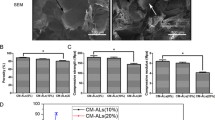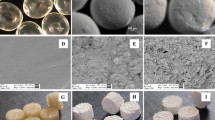Abstract
Sustained delivery of growth factors has emerged as an essential requirement for bone tissue engineering applications for the treatment of various kinds of bone defects. Chitosan (CH) has attracted particular attention for drug delivery and bone tissue engineering because of its favorable biocompatibility and biodegradability. In this study, a composite microsphere system containing CH and nanohydroxyapatite (nHA)-alendronate (AL) particles was fabricated by employing both emulsification and cross-linking strategies. The microspheres were characterized for their surface morphology, composition, size distribution, drug loading efficiency and release properties. The results showed that loading efficiency and sustained release of hydrophilic AL were significantly improved, which is ideal for locally sustained release in the bone microenvironment. In vitro osteogenic studies showed that the microspheres could enhance the osteogenic activity of rabbit adipose-derived stem cells. In conclusion, the CH/nHA-AL composite microspheres exhibit promising properties as a candidate for local treatment for bone defects.







Similar content being viewed by others
References
Kenley RA, Yim K, Abrams J, Ron E, Turek T, Marden LJ, et al. Biotechnology and bone graft substitutes. Pharm Res. 1993;10(10):1393–401.
Bostrom MP, Saleh KJ, Einhorn TA. Osteoinductive growth factors in preclinical fracture and long bone defects models. Orthoped Clin North Am. 1999;30(4):647–58.
Lieberman JR, Daluiski A, Einhorn TA. The role of growth factors in the repair of bone. Biology and clinical applications. J Bone Joint Surg Am Vol. 2002;84(A(6)):1032–44.
Nauth A, Ristevski B, Li R, Schemitsch EH. Growth factors and bone regeneration: how much bone can we expect? Injury. 2011;42(6):574–9.
Seeherman H, Wozney JM. Delivery of bone morphogenetic proteins for orthopedic tissue regeneration. Cytokine Growth Factor Rev. 2005;16(3):329–45.
Vo TN, Kasper FK, Mikos AG. Strategies for controlled delivery of growth factors and cells for bone regeneration. Adv Drug Deliv Rev. 2012;64(12):1292–309.
Malafaya PB, Silva GA, Baran ET, Reis RL. Drug delivery therapies II. Strategies for delivering bone regenerating factors. Curr Opin Solid State Mater Sci. 2002;6(4):297–312.
Reves BT, Bumgardner JD, Haggard WO. Fabrication of crosslinked carboxymethylchitosan microspheres and their incorporation into composite scaffolds for enhanced bone regeneration. J Biomed Mater Res B. 2013;101(4):630–9.
Low SA, Kopecek J. Targeting polymer therapeutics to bone. Adv Drug Deliv Rev. 2012;64(12):1189–204.
Han B, Wang HT, Liu HY, Hong H, Lv W, Shang ZH. Preparation of pingyangmycin PLGA microspheres and related in vitro/in vivo studies. Int J Pharm. 2010;398(1–2):130–6.
Hernán Pérez de la Ossa D, Ligresti A, Gil-Alegre ME, Aberturas MR, Molpeceres J, Di Marzo V. Poly-ε-caprolactone microspheres as a drug delivery system for cannabinoid administration: development, characterization and in vitro evaluation of their antitumoral efficacy. J Control Release. 2012;161(3):927–32.
Sionkowska A. Current research on the blends of natural and synthetic polymers as new biomaterials: review. Prog Polym Sci. 2011;36(9):1254–76.
Dash M, Chiellini F, Ottenbrite RM, Chiellini E. Chitosan-A versatile semi-synthetic polymer in biomedical applications. Prog Polym Sci. 2011;36(8):981–1014.
Patil SB, Sawant KK. Chitosan microspheres as a delivery system for nasal insufflation. Colloids Surf B. 2011;84(2):384–9.
Jameela SR, Kumary TV, Lal AV, Jayakrishnan A. Progesterone-loaded chitosan microspheres: a long acting biodegradable controlled delivery system. J Control Release. 1998;52(1–2):17–24.
Jameela SR, Jayakrishnan A. Glutaraldehyde cross-linked chitosan microspheres as a long-acting biodegradable drug-delivery vehicle—studies on the in-vitro release of mitoxantrone and in-vivo degradation of microspheres in rat muscle. Biomaterials. 1995;16(10):769–75.
Niu XF, Feng QL, Wang MB, Guo XD, Zheng QX. Porous nano-HA/collagen/PLLA scaffold containing chitosan microspheres for controlled delivery of synthetic peptide derived from BMP-2. J Control Release. 2009;134(2):111–7.
Wang J, Wang BA, Schwendeman SP. Characterization of the initial burst release of a model peptide from poly(d, l-lactide-co-glycolide) microspheres. J Control Release. 2002;82(2–3):289–307.
Gentile P, Mattioli-Belmonte M, Chiono V, Ferretti C, Baino F, Tonda-Turo C, et al. Bioactive glass/polymer composite scaffolds mimicking bone tissue. J Biomed Mater Res. 2012;100(10):2654–67.
Liu Q, de Wijn JR, van Blitterswijk CA. A study on the grafting reaction of isocyanates with hydroxyapatite particles. J Biomed Mater Res. 1998;40(3):358–64.
Miyazaki T, Ishikawa K, Shirosaki Y, Ohtsuki C. Organic-inorganic composites designed for biomedical applications. Biol pharm bull. 2013;36(11):1670–5.
Bigi A, Panzavolta S, Roveri N. Hydroxyapatite-gelatin films: a structural and mechanical characterization. Biomaterials. 1998;19(7–9):739–44.
Ding CC, Teng SH, Pan H. In-situ generation of chitosan/hydroxyapatite composite microspheres for biomedical application. Mater Lett. 2012;79:72–4.
Boanini E, Gazzano M, Rubini K, Bigi A. Composite nanocrystals provide new insight on alendronate interaction with hydroxyapatite structure. Adv Mater. 2007;19(18):2499.
Shi X, Wang Y, Varshney RR, Ren L, Zhang F, Wang DA. In-vitro osteogenesis of synovium stem cells induced by controlled release of bisphosphate additives from microspherical mesoporous silica composite. Biomaterials. 2009;30(23–24):3996–4005.
von Knoch F, Jaquiery C, Kowalsky M, Schaeren S, Alabre C, Martin I, et al. Effects of bisphosphonates on proliferation and osteoblast differentiation of human bone marrow stromal cells. Biomaterials. 2005;26(34):6941–9.
Boanini E, Torricelli P, Gazzano M, Giardino R, Bigi A. Alendronate-hydroxyapatite nanocomposites and their interaction with osteoclasts and osteoblast-like cells. Biomaterials. 2008;29(7):790–6.
Nishikawa M, Akatsu T, Katayama Y, Yasutomo Y, Kado S, Kugal N, et al. Bisphosphonates act on osteoblastic cells and inhibit osteoclast formation in mouse marrow cultures. Bone. 1996;18(1):9–14.
Duque G, Rivas D. Alendronate has an anabolic effect on bone through the differentiation of mesenchymal stem cells. J Bone Miner Res. 2007;22(10):1603–11.
Wang CZ, Chen SM, Chen CH, Wang CK, Wang GJ, Chang JK, et al. The effect of the local delivery of alendronate on human adipose-derived stem cell-based bone regeneration. Biomaterials. 2010;31(33):8674–83.
Giger EV, Castagner B, Leroux JC. Biomedical applications of bisphosphonates. J Control Release. 2013;167(2):175–88.
Shi X, Wang Y, Ren L, Gong Y, Wang DA. Enhancing alendronate release from a novel PLGA/hydroxyapatite microspheric system for bone repairing applications. Pharm Res. 2009;26(2):422–30.
Chen J, Luo Y, Hong L, Ling Y, Pang J, Fang Y, et al. Synthesis, characterization and osteoconductivity properties of bone fillers based on alendronate-loaded poly(epsilon-caprolactone)/hydroxyapatite microspheres. J Mater Sci Mater Med. 2011;22(3):547–55.
Sterodimas A, de Faria J, Nicaretta B, Pitanguy I. Tissue engineering with adipose-derived stem cells (ADSCs): current and future applications. J Plast Reconstr Aesthet Surg. 2010;63(11):1886–92.
Kim EH, Heo CY. Current applications of adipose-derived stem cells and their future perspectives. World J Stem Cells. 2014;6(1):65–8.
Romagnoli C, Brandi ML. Adipose mesenchymal stem cells in the field of bone tissue engineering. World J Stem Cells. 2014;6(2):144–52.
Mirsaidi A, Genelin K, Vetsch JR, Stanger S, Theiss F, Lindtner RA, et al. Therapeutic potential of adipose-derived stromal cells in age-related osteoporosis. Biomaterials. 2014;35(26):7326–35.
Yun YP, Kim SJ, Lim YM, Park K, Kim HJ, Jeong SI, et al. The effect of alendronate-loaded polycarprolactone nanofibrous scaffolds on osteogenic differentiation of adipose-derived stem cells in bone tissue regeneration. J Biomed Nanotechnol. 2014;10(6):1080–90.
Niu X, Feng Q, Wang M, Guo X, Zheng Q. Porous nano-HA/collagen/PLLA scaffold containing chitosan microspheres for controlled delivery of synthetic peptide derived from BMP-2. J Control Release. 2009;134(2):111–7.
Long ML, Huang HL, Yan F, Ji SD. Determination of Alendronate Sodium in Compound Alendronate Sodium Tablets by the Molybdenum Blue Colorimetry. Pharm J Chin PLA. 2006;22(6):434–6.
Qian YF, Zhang KH, Chen F, Ke QF, Mo XM. Cross-linking of gelatin and chitosan complex nanofibers for tissue-engineering scaffolds. J Biomater Sci Polym Ed. 2011;22(8):1099–113.
Kas HS. Chitosan: properties, preparations and application to microparticulate systems. J Microencapsul. 1997;14(6):689–711.
Felt O, Buri P, Gurny R. Chitosan: a unique polysaccharide for drug delivery. Drug Dev Ind Pharm. 1998;24(11):979–93.
Wang LY, Gu YH, Zhou QZ, Ma GH, Wan YH, Su ZG. Preparation and characterization of uniform-sized chitosan microspheres containing insulin by membrane emulsification and a two-step solidification process. Colloids Surf B. 2006;50(2):126–35.
Liu X, Chen Y, Huang Q, He W, Feng Q, Yu B. A novel thermo-sensitive hydrogel based on thiolated chitosan/hydroxyapatite/beta-glycerophosphate. Carbohydr Polym. 2014;110:62–9.
Teng SH, Lee EJ, Yoon BH, Shin DS, Kim HE, Oh JS. Chitosan/nanohydroxyapatite composite membranes via dynamic filtration for guided bone regeneration. J Biomed Mater Res A. 2009;88(3):569–80.
Zhu A, Lu Y, Zhou Y, Dai S. Spherical N-carboxyethylchitosan/hydroxyapatite nanoparticles prepared by ionic diffusion process in a controlled manner. J Mater Sci Mater Med. 2010;21(12):3095–101.
Bagheri-Khoulenjani S, Mirzadeh H, Etrati-Khosroshahi M, Shokrgozar MA. Particle size modeling and morphology study of chitosan/gelatin/nanohydroxyapatite nanocomposite microspheres for bone tissue engineering. J Biomed Mater Res A. 2013;101(6):1758–67.
Dini E, Alexandridou S, Kiparissides C. Synthesis and characterization of cross-linked chitosan microspheres for drug delivery applications. J Microencapsul. 2003;20(3):375–85.
Samdancioglu S, Calis S, Sumnu M, Atilla Hincal A. Formulation and in vitro evaluation of bisphosphonate loaded microspheres for implantation in osteolysis. Drug Dev Ind Pharm. 2006;32(4):473–81.
Acknowledgments
This work was supported by the Doctoral Scientific Research Funding Program of Central South University and Changsha Municipal Sci-Tech Project of China (K1101025-31). The authors would like to thank Dr. Yibing Qyang, Dr. Zhengxin Jiang and Ms. Carol Suh for editing. The authors also thank Wenhu Zhou and Yan Tang for technical assistance and Zili Wang for providing the rabbit adipose-derived stem cells.
Author information
Authors and Affiliations
Corresponding author
Electronic supplementary material
Below is the link to the electronic supplementary material.
Rights and permissions
About this article
Cite this article
Wu, H., Xu, Y., Liu, G. et al. Emulsion cross-linked chitosan/nanohydroxyapatite microspheres for controlled release of alendronate. J Mater Sci: Mater Med 25, 2649–2658 (2014). https://doi.org/10.1007/s10856-014-5289-y
Received:
Accepted:
Published:
Issue Date:
DOI: https://doi.org/10.1007/s10856-014-5289-y




